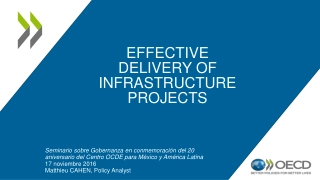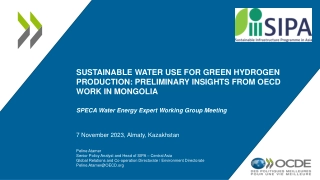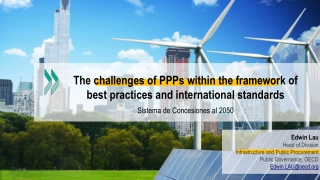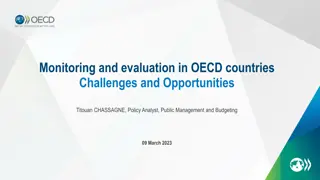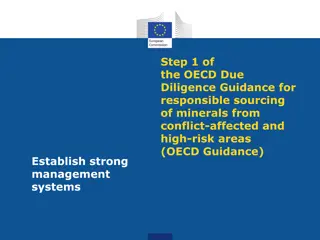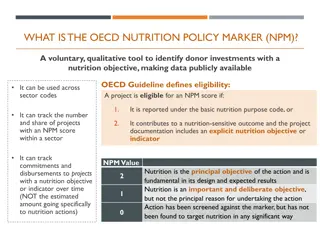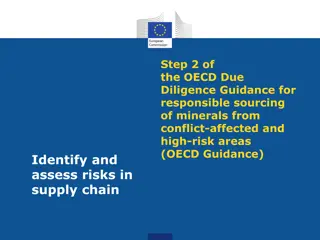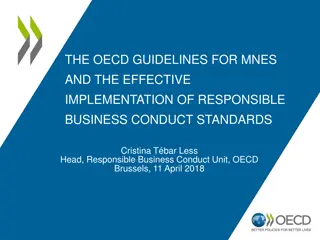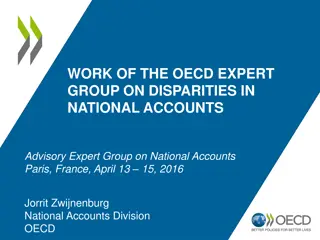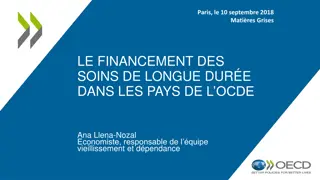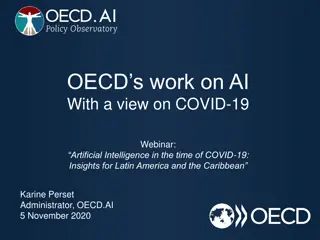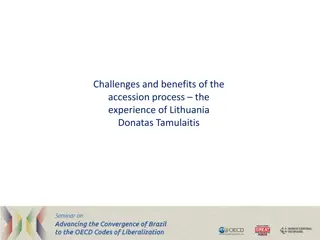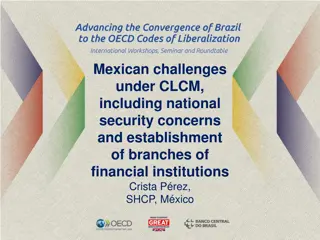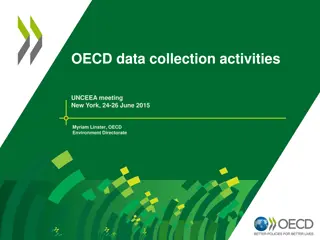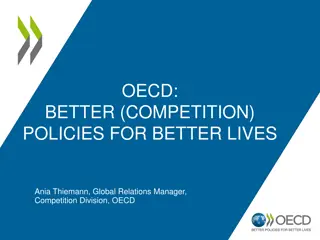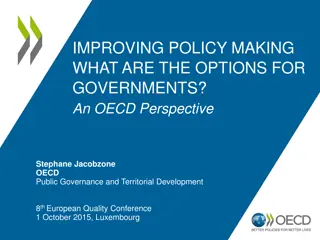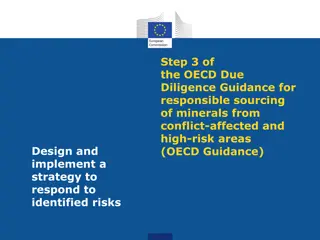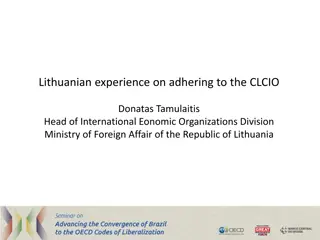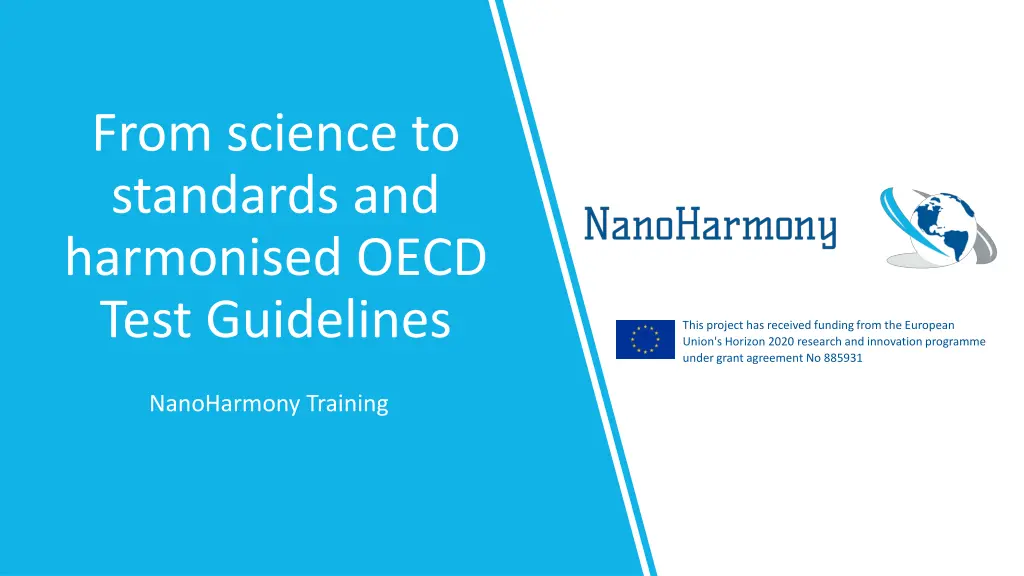
Training on Harmonised OECD Test Guidelines
Explore the NanoHarmony project funded by the EU, focusing on developing and validating test methods for OECD guidelines. Learn about the importance of standardised test methods, the role of the OECD, relevant committees, and the process of guideline development. Discover how science contributes to harmonised standards and test methods.
Download Presentation

Please find below an Image/Link to download the presentation.
The content on the website is provided AS IS for your information and personal use only. It may not be sold, licensed, or shared on other websites without obtaining consent from the author. If you encounter any issues during the download, it is possible that the publisher has removed the file from their server.
You are allowed to download the files provided on this website for personal or commercial use, subject to the condition that they are used lawfully. All files are the property of their respective owners.
The content on the website is provided AS IS for your information and personal use only. It may not be sold, licensed, or shared on other websites without obtaining consent from the author.
E N D
Presentation Transcript
From science to standards and harmonised OECD Test Guidelines This project has received funding from the European Union's Horizon 2020 research and innovation programme under grant agreement No 885931 NanoHarmony Training
Conditions of use The training material was developed within the project NanoHarmony (EU Horizon 2020 No. 885931). Attribution-NonCommercial 4.0 International (CC BY-NC 4.0): You are free to: Share copy and redistribute the material in any medium or format Adapt remix, transform, and build upon the material The licensor cannot revoke these freedoms as long as you follow the license terms. Under the following terms: Attribution You must give appropriate credit, provide a link to the license, and indicate if changes were made. You may do so in any reasonable manner, but not in any way that suggests the licensor endorses you or your use. NonCommercial You may not use the material for commercial purposes. No additional restrictions You may not apply legal terms or technological measures that legally restrict others from doing anything the license permits. From science to standards and harmonised OECD Test Guidelines
NanoHarmony The project Develop and validate Test Methods for OECD TGs/GDs The NanoHarmony legacy White Paper Training Material Formation of a network to interact with all relevant stakeholders Regular Online Workshops TGs and GDs for NMs Process Mentor Develop a structure to translate science into test methods used in regulation www.nanoharmony.eu + 18 int. assoc. partners From science to standards and harmonised OECD Test Guidelines
NanoHarmony Training: From science to standards and harmonised OECD Test Guidelines This set of slides provides a low-level entry into the topic of standards and harmonised OECD Test Guidelines and how science can contribute to this. The training set provides essential information on the topics of harmonisation of test methods, OECD and its relevant committees and documents, and the process of OECD Test Guideline development. This material was developed mid-2023. The Training Material is divided into 4 different modules, each focussing on a specific topic: 1. Importance of standardised and harmonised test methods What are harmonised test methods, why are they relevant and what are resulting benefits? How can my science contribute to an OECD Test Guideline? How are standards and harmonised test methods used? How does OECD fit in with other standardisation activities? The OECD and its relevant committees What is the OECD and which committees are relevant? What is the political structure of the OECD? Who are National Coordinators? The different documents in the OECD Test Guidelines Programme What are the different OECD documents? What are advantages of getting involved in their development? The process of development of OECD documents How is the OECD Test Guideline development process structured? Which stakeholders are involved in the development/revision/adaptation of OECD TG/GDs? How can stakeholders get engaged in the process? Further, more detailed information on the different phases of the OECD process is provided by the 2. 3. www.testguideline-development.org 4. From science to standards and harmonised OECD Test Guidelines
The process of development of OECD documents This project has received funding from the European Union's Horizon 2020 research and innovation programme under grant agreement No 885931 Module 4 NanoHarmony Training: From science to standards and harmonised OECD Test Guidelines
OECD Test Guideline Development Process April mid-Nov mid-Nov/April April 2 months + 1 or more years June/mid-Feb mid-Feb TG/GD commenting rounds at WNT Final SPSF Formal SPSF approval at WNT Submission of SPSF at WNT Project at WNT with 1 or more WNT Expert Group Meetings Approval by WNT Submission to WNT commenting round at WNT Pre-OECD phase Project definition at OECD Development at OECD Commenting and approval at OECD Phase 3 Use of OECD TGs/GDs Phase 0 Phase 1 Phase 2 Phase 4 From science to standards and harmonised OECD Test Guidelines
OECD Test Guideline Development Process In reality Revision and updating of existing TGs or development of new ones April mid-Nov mid-Nov/April April 2 months + 1 or more years June/mid-Feb mid-Feb TG/GD commenting rounds at WNT Final SPSF Formal SPSF approval at WNT Submission of SPSF at WNT Project at WNT with 1 or more WNT Expert Group Meetings Approval by WNT Submission to WNT commenting round at WNT Pre-OECD phase Project definition at OECD Development at OECD Commenting and approval at OECD Phase 3 Use of OECD TGs/GDs Phase 0 Phase 1 Phase 2 Phase 4 With support of OECD Working Parties (e.g. WPMN) Potentially the method does not need to become an OECD TG Possibly several commenting rounds Can take several years From science to standards and harmonised OECD Test Guidelines
OECD Test Guideline Development Process In reality Revision and updating of existing TGs or development of new ones Regulators Policymakers / Member states / Institutions Industry / Service providers / CROs CONTINUOUS INTERACTIONS WITH STAKEHOLDERS THROUGHOUT THE ENTIRE PROCESS Scientists mid-Nov National Coordinator(s) 2 months + 1 or more years Standardisation bodies June/mid-Feb NGOs Networks / Communities April mid-Nov/April April mid-Feb TG/GD commenting rounds at WNT Final SPSF Formal SPSF approval at WNT Submission of SPSF at WNT Project at WNT with 1 or more WNT Expert Group Meetings Approval by WNT Submission to WNT commenting round at WNT Pre-OECD phase Project definition at OECD Development at OECD Commenting and approval at OECD Phase 3 Use of OECD TGs/GDs Phase 0 Phase 1 Phase 2 Phase 4 With support of OECD Working Parties (e.g. WPMN) Potentially the method does not need to become an OECD TG Possibly several commenting rounds Can take several years From science to standards and harmonised OECD Test Guidelines
OECD Test Guideline Development Process In reality Revision and updating of existing TGs or development of new ones Regulators Policymakers / Member states / Institutions Industry / Service providers / CROs CONTINUOUS INTERACTIONS WITH STAKEHOLDERS THROUGHOUT THE ENTIRE PROCESS Scientists mid-Nov National Coordinator(s) 2 months + 1 or more years Standardisation bodies June/mid-Feb NGOs Networks / Communities April mid-Nov/April April mid-Feb TG/GD commenting rounds at WNT Final SPSF Formal SPSF approval at WNT Submission of SPSF at WNT Project at WNT with 1 or more WNT Expert Group Meetings Approval by WNT Submission to WNT commenting round at WNT Pre-OECD phase Taking more time at the beginning usually saves time towards the end Project definition at OECD Development at OECD Commenting and approval at OECD Phase 3 Use of OECD TGs/GDs Phase 0 Phase 1 Phase 2 Phase 4 With support of OECD Working Parties (e.g. WPMN) Potentially the method does not need to become an OECD TG Possibly several commenting rounds Can take several years From science to standards and harmonised OECD Test Guidelines
OECD Test Guideline Development Process Submission to WNT 3 4 April SPSF 1 Project at WNT with 1 or more WNT Expert Group Meetings 2 mid-Nov mid-Nov/April April 2 months + 1 or more years June/mid-Feb mid-Feb Pre-OECD phase 0 TG/GD commenting rounds at WNT Final Formal SPSF approval at WNT Submission of SPSF at WNT Approval by WNT commenting round at WNT Project definition at OECD Development at OECD Commenting and approval at OECD Phase 3 Use of OECD TGs/GDs Phase 0 Phase 1 Phase 2 Phase 4 From science to standards and harmonised OECD Test Guidelines
Pre-OECD phase Phase 0 Potential financial support Alignment with other OECD TGs/GDs Regulatory needs Potential use of the results Pre-screening of regulatory needs Towards OECD Scientific background Practicability of the method Key issues identification Predictivity of the method Lead countries supported by research institutions From science to standards and harmonised OECD Test Guidelines
Pre-OECD phase Phase 0 Member countries, EU, ... OECD Potential financial support Alignment with other OECD TGs/GDs Regulators Regulatory needs National Coordinators Regulators, Industry, Scientists Potential use of the results Pre-screening of regulatory needs Exchange with important player and key stakeholders Towards OECD Scientific background Practicability of the method Key issues identification Laboratories, CROs Predictivity of the method Regulators Industry Regulators Industry Lead countries supported by research institutions From science to standards and harmonised OECD Test Guidelines
Pre-OECD phase Phase 0 Member countries, EU, ... OECD Potential financial support Alignment with other OECD TGs/GDs Identification of relevant SOPs Regulators Regulatory needs National Coordinators Regulators, Industry, Scientists Potential use of the results Pre-screening of regulatory needs Exchange with important player and key stakeholders Process documentation Scientific background Data gaps analysis and data requirements Practicability of the method Key issues identification Laboratories, CROs Predictivity of the method Regulators Industry Regulators Industry Lead countries supported by research institutions From science to standards and harmonised OECD Test Guidelines
Expert groups needed for TG development The development of Test Guidelines relies heavily on experts. For each Test Guideline an Ad Hoc Group of experts is formed to support the project. An expert group can already help in development of the project proposal. Experts are generally nominated by the National Coordinators. Project leads can identify experts in their own network & encourage their involvement/nomination. For development or adaptation of Test Guidelines for nanomaterials (and advanced materials) the WNT collaborates closely with the WPMN. Joint Expert Group with experts from both groups. OECD Secretariat can support in formation of an expert group. From science to standards and harmonised OECD Test Guidelines
Networks of experts in OECD Working Group of National Coordinators of the TG Programme Working Party on Manufactured Nanomaterials collaboration Topics: Joint WPMN-WNT Expert Groups (JEG): Physico-Chemical properties of manufactured nanomaterials Ecotoxicity and environmental fate of manufactured nanomaterials Nanoparticles in biological samples Nanomaterials intestinal fate Developmental Toxicity / Developmental Neurotoxicity Ecotoxicity Environmental Fate and Behaviour Genotoxicity / Carcinogenicity In vitro immunotoxicity testing Metal release Nanomaterial Safety Testing Reproductive toxicity Skin Eye Irritation / Phototoxicity Skin Sensitisation Toxicokinetics From science to standards and harmonised OECD Test Guidelines
Project definition at OECD Phase 1 New proposals to the OECD brought forward by a lead Member country What is needed to start the OECD document development? Scope of the project, purpose, use and limitations Maturity of science Provide supporting information on the validation status Scientific and regulatory acceptance Draft workplan for development of the proposal Need for expert groups (regulators, industry, scientist, ...) Animal welfare issues addressed Contribution to further international harmonisation of hazard and risk assessment Issues and / or endpoints of major human health or environmental concerns ... SPSF: Standard Project Submission Form Deadline for SPSF submission by the National Coordinator is 15thNovember Guidance Document for the Development of OECD Guidelines for Testing of Chemicals (as revised in 2009) www.oecd.org/env/ehs/testing/49803789.pdf From science to standards and harmonised OECD Test Guidelines
Project definition at OECD Phase 1 Knowledge about the process is key Lead country and expert group work together on technical aspects OECD Secretariat can help form an expert group for the project Secretariat will contact Member countries to nominate national experts Raising awareness of the strategy developed is crucial Already in the SPSF the focus should be clear, e.g. details on revisions Ensure regular meetings with (nominated) experts Ensure good communication with National Coordinators Helps preempting National Coordinator s comments in the latter stages For projects with a focus on nanomaterials and advanced materials: Use the expertise of the WPMN, before submitting the project to WNT Hints for a successful submission and start: Standard Project Submission Form (SPSF) - template www.oecd.org/chemicalsafety/testing/standard-project-submission-form.pdf From science to standards and harmonised OECD Test Guidelines
Project definition at OECD Phase 1 Project lead and National Coordinator work closely together in development of SPSF. National Coordinator submits the SPSF to OECD Deadline 15thNovember. Project lead ensures that SPSF is available at least two weeks in advance. Experts from Member countries (via their National Coordinators) can provide comments on the SPSF Lead country (and project lead) address comments and adapt SPSF where needed Each comment is addressed in a response to comments An adapted SPSF is submitted to the WNT February If agreed during their meeting (April) the WNT will approve the SPSF The project will be included in the Workplan of the Test Guideline Programme From science to standards and harmonised OECD Test Guidelines
Development at OECD Phase 2 Scientific Acceptance Clarity of experimental data is important Clarity of the applicability domain covered Clarity / transparency of the protocol Fit-for-purpose validation Sufficient characterization of the test system Series of reference chemicals preferably coded to exclude bias Clear data interpretation / prediction model Availability of data in public domain (preferably in an independent peer reviewed publication) Good Laboratory Practice (GLP) . Test outcomes should enable government or regulator to make a decision From science to standards and harmonised OECD Test Guidelines
Development at OECD Phase 2 Purpose of validation Getting confidence in the outcomes of a method (needed for regulatory purposes and the general public) Learning about the applicability and the accuracy of a proposed experimental method Learning about the predictivity of a method or a model Identifying factors that can affect the results variability Performing statistical variability assessment Procedures for validation Experiments with several different materials Intra-laboratory comparison (in-laboratory variability) Inter-laboratory comparison (between-laboratory variability) Considering international (global) participation From science to standards and harmonised OECD Test Guidelines
Development at OECD Phase 2 Value of validation an example Nanoparticle size determination using NTA Coefficient of Variance (%) RR1: Use of in house protocols RR2: Mandatory protocol provided RR3: Better controlled shipments, disposables provided, aligning software versions, recalibration of systems RR4: More complex samples (bimodal samples) in more complex media (biological) Hole et al. 2013, doi: 10.1007/s11051-013-2101-8 From science to standards and harmonised OECD Test Guidelines
Development at OECD Phase 2 Validation report Underpins applicability and accuracy of a TG Accompanies the TG at the end as supporting information Details on Inter-Laboratory Comparisons (ILCs): How was the round robin test designed? Was it a validation of the results? Laboratories participating Chemicals tested Conclusions From science to standards and harmonised OECD Test Guidelines
Development at OECD Phase 2 Drafting of Test Guideline Introduction / scope Initial considerations and limitations / applicability domain Principle of the test Information on the test substance Validity of the test Short description of the method Detailed procedure Data to gather and interpretation Minimal reporting requirements ... Discussions between method developers and regulators (in expert group) Issue solving attitude of all stakeholders From science to standards and harmonised OECD Test Guidelines
Commenting and approval at OECD Phase 3 Exact wording of the TG/GD is finalized Commenting and approval by OECD Member countries (Usually two commenting rounds combined duration of 10 months) Scrutiny of (draft) text of the TG/GD Includes (further) scrutiny of validation Comments will focus on finalized OECD TG with regulatory acceptance A clear regulatory context in several countries Clear intended use of the assay or battery of assays Broad availability / accessibility of the assay Guarantee of sustainability / availability of methodology From science to standards and harmonised OECD Test Guidelines
Commenting and approval at OECD Phase 3 Political aspects of the TG development process and commenting International cooperation and exchange Exchange with testing laboratories, industries, regulators, risk assessors, scientists, Anticipating comments helps with going through the commenting rounds (e.g. writing the TG draft as easy to understand as possible) All comments that are raised during the commenting rounds need to be addressed Publication of the TG/GD on the OECD website From science to standards and harmonised OECD Test Guidelines
Use and update of OECD TGs/GDs Phase 4 Documents are being used for different purposes: Regulatory compliance (industry, contract research organisations (CROs), etc.) Facilitating comparison of results (scientific community) International cooperation (industry, scientific community) Feedback on issues with TGs/GDs Feedback can be provided to the Secretariat and the National Coordinators Users include Industry, CROs, small or medium-sized enterprises (SMEs) Risk assessors Academic scientists ... From science to standards and harmonised OECD Test Guidelines
Take Home Messages Know the process prepare and be aware that processes/phases may go in parallel Remain a clear scope throughout the process Know the National Coordinator and work closely together OECD TG/GD Process Mentor www.testguideline- development.org Ensure collaboration between stakeholders (different groups and nationalities) Ensure funding for the OECD process itself (not only for method development) From science to standards and harmonised OECD Test Guidelines
Sources for further information OECD Test Guidelines Programme www.oecd.org/chemicalsafety/testing/oecd-guidelines-testing-chemicals-related-documents.htm No. 1 Guidance Document for the Development of OECD Guidelines for Testing of Chemicals (as revised in 2009) www.oecd.org/env/ehs/testing/49803789.pdf No. 34 Guidance Document on the Validation and International Acceptance of New or Updated Test Methods for Hazard Assessment www.oecd.org/officialdocuments/displaydocument/?cote=ENV/JM/MONO(2005)14&doclanguage=en National Coordinators of the Test Guidelines Programme www.oecd.org/chemicalsafety/testing/national-coordinators-test-guidelines-programme.htm Standard Project Submission Form (SPSF) - template www.oecd.org/chemicalsafety/testing/standard-project-submission-form.pdf Test Guidelines www.oecd.org/chemicalsafety/testing/oecdguidelinesforthetestingofchemicals.htm Draft Test Guidelines for public comments www.oecd.org/chemicalsafety/testing/chemicalstestingdraftoecdguidelinesforthetestingofchemicals-sections1-5.htm Guidance and Review in the Series on Testing and Assessment www.oecd.org/chemicalsafety/testing/seriesontestingandassessmentadoptedguidanceandreviewdocuments.htm Draft Guidance and Review documents for public comments www.oecd.org/chemicalsafety/testing/draft-guidance-review-documents-monographs.htm Safety of manufactured nanomaterials OECD www.oecd.org/science/nanosafety NanoHarmony Webinars on List of laboratories compiled by OECD www.oecd.org/chemicalsafety/testing/linkstonationalwebsitesongoodlaboratorypractice.htm NanoHarmony www.nanoharmony.eu NanoHarmony webinars https://www.youtube.com/playlist?list=PLl8XHGDKVfG7jZ0i0mkXOua3YLkMLSCSh NanoHarmony OECD TG/GD Process Mentor www.testguideline-development.org NANOMET www.oecd.org/chemicalsafety/nanomet/ From science to standards and harmonised OECD Test Guidelines

